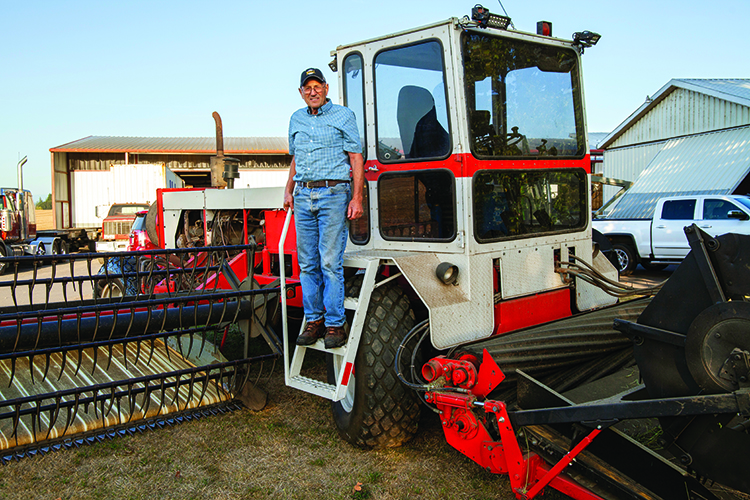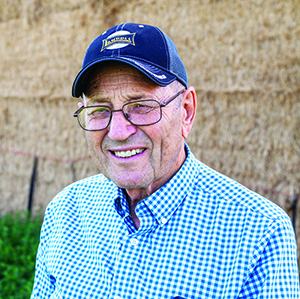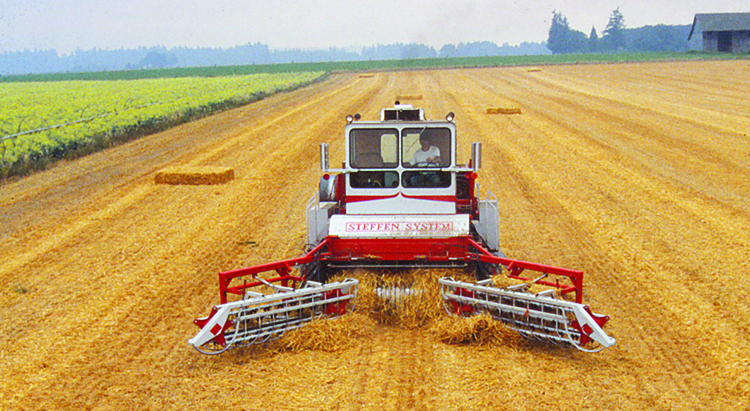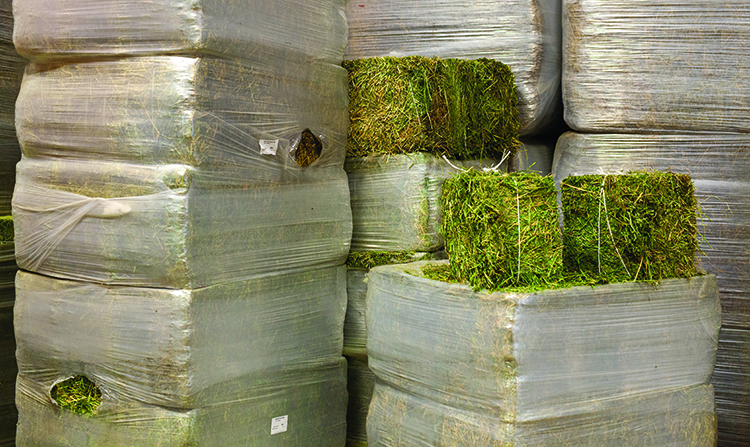
If they don’t bale hay in heaven, then Stan Steffen isn’t interested in making the trip.
Steffen, who is now 78 years old, has spent most of his years making hay near Silverton, Ore., in the western Willamette Valley. He has also devoted a nearly equal amount of his lifetime designing and building equipment for harvesting and handling hay. But don’t ask to see his engineering school diploma . . . such a document doesn’t exist.
What you will find when talking to Steffen is a God-given mechanical mind, a thirst for knowledge, and a drive to always look for a better way. He’s a haying problem solver.
The amiable Steffen credits a lot of what he has learned from talking to knowledgeable acquaintances. Even so, his mechanical abilities go far beyond the result of a conversation. His haymaking machines often had their humble beginnings by being drawn up on the back of a napkin and then modeled from cut up cereal boxes.
No fishing
Steffen’s grandfather moved from Ohio to Oregon in 1877. His father continued the family’s farming and woodcutting business, and Steffen was the youngest of seven children.
“When I was a teenager, my dad bought a New Holland Model 80 wire-tie baler,” Steffen recalled. “My brother was going to run the baler, but then he got drafted into the Korean War. My father then hired a neighbor kid to bale, but he got so frustrated running the baler that he quit. That’s when I got my opportunity to bale hay, and I just haven’t been able to stop.”
In those days of youth, Steffen baled grass hay, wheat straw, and mushroom straw. One day, he told his dad that he wanted to try alfalfa. To that request his dad replied, “No, you’ll never get to go fishing if you put that in.” The young Steffen, however, was more steadfast in his desire to bale alfalfa than reel in a trout.
He won that argument and on one occasion found himself baling alfalfa late at night. “It was tough stuff,” Steffen remembered. “I found a dairy to sell it to, and the guy came back and told me if I could make hay like that he’d buy as much as I could make. That’s when I learned the secret to making good alfalfa — let it get really dry and then wait for a dew.”
It was soon after that experience when Steffen developed a strong market for his alfalfa with all of the dairy farmers who had moved to the area from Holland in the mid-1970s.
Baling and building

As a young adult, Steffen farmed with his older brother, Wayne. One day, Wayne was severely injured and paralyzed from the waist down when a tractor tire fell on him. If both brothers were to continue farming, there was going to have to be some machinery modifications. One need was a bale loader that could be operated using only hand controls.
In 1967, Steffen built a hand-operated bale loader out of an old truck frame and a 1959 Pontiac car body and engine. It lifted 10 two-tie bales and stacked them up to 14 layers high. But that was just the beginning of the hay gizmos and gadgets that would emerge from Steffen’s small farm shop.
Steffen has never been a farmer who wished there was something better or easier for making hay. If it wasn’t available, he simply built what was needed. It was usually at that point that his neighbors would see him using one of his creations and would ask him to build one for them.
One of his other early ventures was a bale accumulator that picked up 10 small square bales. “The requests for this unit got to be too much, so in 1981, we started Steffen Systems to keep up with the orders,” Steffen said. “My brother, who was a real hydraulic genius, another partner, and myself started a manufacturing business in town. I designed everything, and then they built the units.”
About five years into the manufacturing venture, sales started to dwindle along with the farm economy of the late 1980s. It was then that Steffen’s oldest son, David, took over the business, moved it to a rural location outside of Silverton, Ore., and grew it to the successful enterprise it is today — still building bale accumulators, along with bale processors/presses and grapples.
A compression pioneer
It was the early 1980s; as Steffen explained it, he received a visit from Don Ast, a California exporter who was shipping bermudagrass straw to Japan. Steffen had been baling grass seed straw, which was as plentiful in the Willamette Valley back then as it is today. “The difference in those days was people viewed it as a waste product; we’d put it in large piles and burn the stuff,” Steffen explained.
He continued, “Don thought he could sell the product, and so he filled a container with bales and shipped it overseas. It was well received, but I knew that the three-tie bales would need to be compressed to save shipping costs. That led me to design and build my first hay press in 1981.”
Steffen built an improved version of his hay press in 1986, and that one still sits in the corner of farm’s warehouse today, although it is not used any longer. It was during the late 1980s that the demand for hay presses started to grow. In 1988, Steffen designed and built a press for two-tie bales, which was successful and also aided in the growth of David’s resurrected Steffen Systems manufacturing business.
Through the years, the bale compressors have continued to improve and evolve. With the popularity of large square bales, the units now will slice the larger bales into smaller bales before compression takes place. This not only improves on shipping efficiencies, but it also offers a ready market for those clients who prefer the smaller hay packages. Building bale processing units now comprises a large part of the business at Steffen Systems.
Wait . . . there’s more
Steffen’s interest in redefining haymaking didn’t stop with bale handling and compression. Before the days of the large square baler, the mechanically inclined Oregonian developed what he fondly refers to as his “pancake baler,” which he began to develop in 1977 and operated through most of the 1990s. At the time, Farm Show magazine described Steffen’s invention as a “baling breakthrough.” The unique self-propelled machine created a bale that was 90 inches long by 90 inches wide by 16 inches high. The flat bales weighed up to 1,200 pounds.
The 10-wire pancake baler was built with standard Freeman knotters and needles and was capable of baling up to 45 tons of alfalfa per hour. On the front of the baler were mounted wheel rakes, which made raking and baling a single operation. Initially, finding a market for large, flat bales limited popularity. To make the bales more desirable, Steffen built a saw that would slice the bales into five two-tie sections, and then these were double compressed into 46-inch lengths. The pancake baler, like a lot of Steffen’s creations, remains preserved in a pole barn at the farm.

It’s only been in recent years that so-called triple mowers have become popular. The ability to lay out a swath to speed drying along with faster mowing speeds are cited as large advantages. Steffen actually recognized these assets in the mid-1980s when he built a self-propelled triple mower equipped with three separate, 7-foot New Holland sickle mowers.
The mower’s power unit is a Chevrolet V-8 gas engine and the three mowers are driven by hydraulics, making it possible to control each of the three mowing units separately. Steffen has used this mower to cut hay on his farm for the past 35 years.
A hay business, too
Aside from all the inventing, building, and welding, Steffen and his wife, Ruth, have owned and operated Steffen Hay Co. through their many years of marriage. It was on this 300-acre farm that the couple raised five sons and two daughters. Most of the growth of the farm has come through baling standing hay or windrowed straw that they purchase in the Willamette Valley. They also custom process and compress large square bales for numerous clients.
Three of Steffen’s sons remain actively involved in the family hay business. Scott does all of the baling while Troy takes the lead in marketing efforts. The farm’s marketing swath ranges from exporting containers overseas to selling small lots of compressed bales to local horse owners. Dale, another son, can usually be found operating the hay press.
Once the pancake baler was parked in the late 1990s, Steffen had a neighbor make 3x3 large square bales for him. Eventually, his son-in-law, Pat Twede, purchased the baler and did the baling for several years before Steffen Hay Co. purchased the baler and did their own baling.
Steffen Hay Co. currently produces and markets grass straw, high-moisture alfalfa in 1,000-pound plastic-wrapped bales, and dry alfalfa, alfalfa-grass, and orchardgrass hay in compressed, shrink-wrapped bales. All of the hay is tested for forage quality so clients know what they’re buying.
The hay company also works with several grass seed growers to custom harvest alfalfa that is grown as a rotation crop between grass seed crops. In this unique arrangement, Steffen charges for cutting, raking, baling, and marketing the crop. The grass seed grower then gets the proceeds from the hay sale.
These days, Steffen Hay Co. operates a stationary bale press and also a portable truck press. “We used to go to eastern Oregon to press hay on-site,” Steffen said. “By doing so, we could identify the bad bales with dirt and other foreign material in them, then leave them there for the cattle to eat. Our horse customers didn’t appreciate animal bones in their hay,” he added sarcastically. The truck press now stays at the home farm to do small retail lots of hay. This past year, Steffen purchased a new press to replace the farm’s existing stationary machine. The new bale press will also serve as a demonstration model for Steffen Systems’ potential press buyers.

Dryland alfalfa
Living and farming in the eastern Willamette Valley usually means the winters will be wet and the summers will be dry. None of Steffen’s acreage is irrigated. Steffen Hay Co. grows about 125 acres of pure alfalfa and also has some fields of pure orchardgrass and alfalfa-grass mixtures. The remaining acreage is wheat, which is custom combined and used as a rotation crop for alfalfa. “I’m always amazed how well wheat does when it follows alfalfa,” Steffen noted. “We can sometimes hit 150 bushels per acre.”
Steffen’s spring-seeded alfalfa fields face the same major problem that many do in the West — voles. “They are just devastating and essentially determine how long we can keep a particular alfalfa stand,” he explained with a noticeable hint of frustration in his voice. “Voles are the main reason why we have stuck with a sickle bar mower and run it at about 3.5 miles per hour when we cut. We set our header pressure low enough so that it rides up over the piles of soil created by the voles.
“We usually get four cuttings of alfalfa. There’s typically enough rain for the first two cuttings and then we hope for the best on the last two. This is flat land, so what water we do get tends not to runoff,” Steffen added.
Looking forward
With three sons actively engaged in the business, Steffen is not overly concerned about the future Steffen Hay Co. “There’s plenty of room for business expansion, but it’s really hard to find decent labor,” Steffen said. “We have not really grown our owned acreage in 20 years. Instead, we’ve tried to expand our markets.”
Another aspect of the farm that also won’t change is the “do-it-yourself” attitude. “We don’t see a lot of equipment service personnel on this farm,” Steffen chuckled. “We abide by the European way . . . don’t own a piece of equipment unless you know how to fix it.”
Of course there’s also the Stan Steffen way: If you can’t buy it, build it yourself.
This article appeared in the November 2020 issue of Hay & Forage Grower on pages 6 to 8.
Not a subscriber? Click to get the print magazine.

